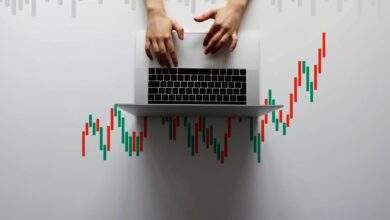Forex Trading for Beginners: A Step-by-Step Guide
This step-by-step guide will teach you about the basics of forex trading for beginners, helping you understand the market and develop a trading strategy.

Forex trading, also known as foreign exchange trading, is the process of buying and selling currencies with the aim of making a profit. It is one of the largest and most liquid financial markets in the world, with a daily trading volume exceeding $6 trillion. Forex trading for beginners can seem complex and intimidating, but with the right guidance, it can be a rewarding endeavor. This step-by-step guide will walk you through the basics of forex trading, helping you understand the market, develop a trading strategy, and manage risks effectively.
Step 1: Understand the Basics of Forex Trading
What is Forex trading?
Forex trading involves the exchange of one currency for another. Currencies are traded in pairs, such as EUR/USD (Euro/US Dollar) or GBP/JPY (British Pound/Japanese Yen). The first currency in the pair is the base currency, and the second is the quote currency. The price of a currency pair represents how much of the quoted currency is needed to purchase one unit of the base currency.
How Does the Forex Market Work?
The forex market operates 24 hours a day, five days a week, across major financial centers in different time zones. Unlike stock markets, which have a centralized exchange, forex trading is conducted over-the-counter (OTC) through a global network of banks, brokers, and financial institutions. The market is influenced by various factors, including economic indicators, geopolitical events, and market sentiment.
Key Terms to Know
- Pip: The smallest price move that a currency pair can make. For most pairs, a pip is 0.0001.
- Spread: The difference between the bid (buy) and ask (sell) price of a currency pair.
- Leverage: a tool that allows traders to control a larger position with a smaller amount of capital. While leverage can amplify profits, it also increases the risk of losses.
- Margin: The amount of money required to open a leveraged position.
- Lot: The size of a trade. A standard lot is 100,000 units of the base currency, while mini and micro lots are 10,000 and 1,000 units, respectively.
Step 2: Choose a Reliable Forex Broker

Regulation and Security
The first step in starting your forex trading journey is to choose a reliable broker. Ensure that the broker is regulated by a reputable financial authority, such as the Financial Conduct Authority (FCA) in the UK, the Commodity Futures Trading Commission (CFTC) in the US, or the Australian Securities and Investments Commission (ASIC). Regulation ensures that the broker adheres to strict financial standards and provides a level of security for your funds.
Trading Platform
A good trading platform is essential for executing trades efficiently. Look for a platform that is user-friendly, offers advanced charting tools, and provides real-time market data. MetaTrader 4 (MT4) and MetaTrader 5 (MT5) are popular choices among forex traders due to their robust features and ease of use.
Fees and Spreads
Different brokers offer varying fee structures, including spreads, commissions, and overnight financing costs. Compare brokers to find one that offers competitive spreads and low fees, as these can significantly impact your overall profitability.
Customer Support
Reliable customer support is crucial, especially for Forex trading beginners. Choose a broker that offers 24/7 customer support through multiple channels, such as live chat, email, and phone.
Step 3: Learn Fundamental and Technical Analysis
Fundamental Analysis
Fundamental analysis involves evaluating economic indicators, central bank policies, and geopolitical events to predict currency movements. Key indicators to watch include:
- Interest Rates: Higher interest rates can attract foreign investment, increasing demand for the currency.
- Gross Domestic Product (GDP): A strong GDP growth rate indicates a healthy economy, which can boost the currency.
- Employment Data: Low unemployment rates are generally positive for a currency, as they indicate a strong labor market.
- Inflation: Moderate inflation is typically good for a currency, while hyperinflation can erode its value.
Technical Analysis
Technical analysis involves studying price charts and using technical indicators to identify trading opportunities. Common tools and indicators include:
- Candlestick Charts: These charts display price movements over a specific period and are useful for identifying trends and patterns.
- Support and Resistance Levels: Support is a price level where a currency pair tends to find buying interest, while resistance is a level where selling interest is typically found.
- Moving Averages: These indicators smooth out price data to identify trends. The 50-day and 200-day moving averages are commonly used.
- Relative Strength Index (RSI): This momentum oscillator measures the speed and change of price movements, helping to identify overbought or oversold conditions.
Step 4: Develop a Trading Strategy
Define Your Goals
Before you start trading, it’s essential to define your financial goals and risk tolerance. Are you looking to generate a steady income, or are you aiming for long-term capital growth? Your goals will influence your trading style and the strategies you employ.
Choose a Trading Style
There are several trading styles to choose from, depending on your time commitment and risk tolerance:
- Scalping: This involves making multiple trades throughout the day to capture small price movements. Scalpers hold positions for a few seconds to minutes.
- Day Trading: Day traders open and close positions within the same trading day, avoiding overnight risks.
- Swing Trading: Swing traders hold positions for several days or weeks, aiming to capture medium-term price movements.
- Position Trading: This is a long-term strategy where traders hold positions for weeks, months, or even years, based on fundamental analysis.
Risk Management
Risk management is crucial in forex trading to protect your capital. Key risk management techniques include:
- Setting Stop-Loss Orders: A stop-loss order automatically closes a trade at a predetermined price level to limit losses.
- Using Proper Position Sizing: Never risk more than 1-2% of your trading capital on a single trade.
- Diversifying Your Portfolio: Avoid putting all your capital into a single currency pair. Diversification can help spread risk.
Backtesting and Demo Trading
Before risking real money, it’s advisable to backtest your trading strategy using historical data and practice trading on a demo account. Demo trading allows you to gain experience and refine your strategy without the risk of losing capital.
Step 5: Open a Live Trading Account
Start Small
Once you’re confident in your trading strategy, you can open a live trading account. Start with a small amount of capital and gradually increase your position sizes as you gain experience and confidence.
Monitor Your Trades
Keep a close eye on your open positions and monitor the market for any significant news or events that could impact your trades. Use technical indicators and chart patterns to make informed decisions.
Keep a Trading Journal
Maintaining a trading journal is essential for tracking your performance and identifying areas for improvement. Record details of each trade, including the entry and exit points, the reason for the trade, and the outcome. Review your journal regularly to learn from your successes and mistakes.
Step 6: Continuously Educate Yourself
Stay Informed
The forex market is constantly evolving, and staying informed about market developments is crucial. Follow financial news, read market analysis, and keep an eye on economic calendars to stay ahead of market-moving events.
Learn from Experts
Consider learning from experienced traders by attending webinars, reading books, and following reputable trading blogs. Many brokers offer educational resources, including tutorials, articles, and videos, to help you improve your trading skills.
Adapt and Evolve
As you gain experience, you may need to adapt your trading strategy to changing market conditions. Be open to learning new techniques and refining your approach to stay competitive in the forex market.
Conclusion
Forex trading offers immense opportunities for profit, but it also comes with significant risks. By understanding the basics, choosing a reliable broker, developing a solid trading strategy, and managing risks effectively, beginners can navigate the forex market with confidence. Remember that success in forex trading requires continuous learning, discipline, and patience. Start small, stay informed, and always prioritize risk management to build a sustainable trading career.
With this step-by-step guide, you now have a solid foundation to begin your forex trading journey. Happy trading!





